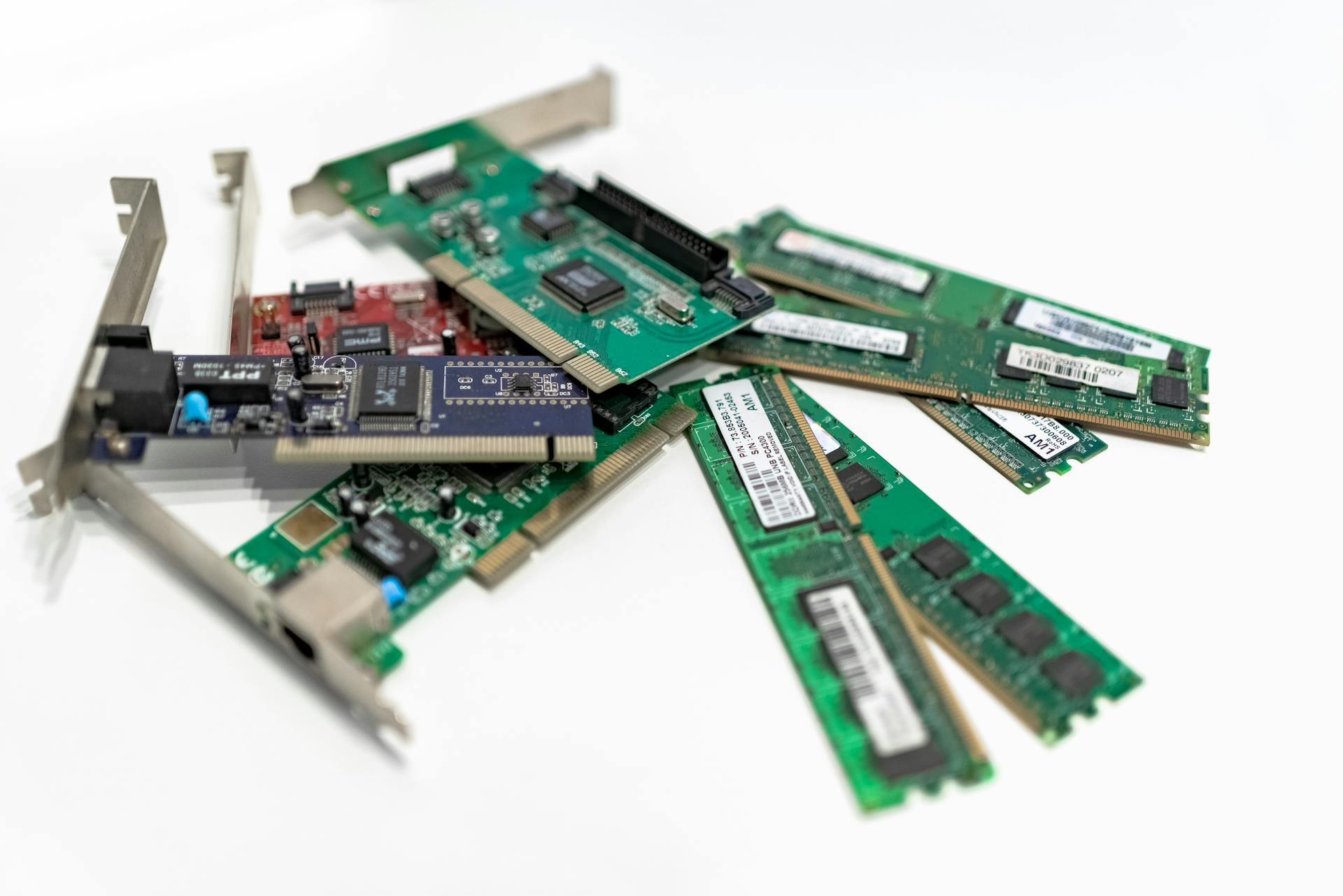
Understanding PCI DSS scope is crucial for any organization that handles credit card information. The scope of PCI DSS refers to the specific areas of an organization's environment that must comply with the Payment Card Industry Data Security Standard.
To determine the scope of PCI DSS, you need to identify all systems and components that store, process, or transmit cardholder data. This includes not just the primary system but also any supporting systems, such as databases, servers, and networks.
The scope may also include third-party vendors and service providers that have access to cardholder data. In one case, a company's PCI DSS scope included its e-commerce platform, payment gateway, and database server.
A different take: I M B Bank Share Price Today
What is PCI DSS Scope?
PCI DSS scope refers to the systems, people, and processes subject to PCI DSS requirements. This includes any system component that can affect cardholder security or access cardholder data.
To be considered out of scope, a system must meet four specific criteria. These criteria include not storing, processing, or transmitting cardholder data or sensitive authentication data, not being in the same network segment as systems that handle or transmit cardholder data, not being able to connect to the cardholder data environment, and not impacting the security of any in-scope systems.
Intriguing read: Faster Payment System
The PCI scoping process involves examining your cardholder data environment and connected systems to identify which system components fall into the scope of a PCI assessment. This process helps minimize the scope by applying PCI security controls only to systems that must handle or connect to cardholder data.
Here's a breakdown of the three categories defined by the PCI Standards Council:
- In-scope systems: These systems are in the cardholder environment and directly handle cardholder data or sensitive authentication data.
- Connected-to or impacting systems: These systems connect to or could affect the security of in-scope systems, even if they don't directly handle cardholder data.
- Out-of-scope systems: These systems don't interact with or impact the security of cardholder data and are not part of the PCI scope.
By understanding the PCI DSS scope, organizations can limit the systems that handle cardholder data and reduce their security burden.
Benefits of Descoping
Descoping is a game-changer when it comes to simplifying compliance and reducing costs. By minimizing your organization's compliance scope, you can reduce the financial cost associated with PCI DSS audits.
Descoping can also save you a significant amount of time and effort. By reducing the number of security controls applicable to your environment, you can cut down on the time needed to perform the PCI DSS audit.
Intriguing read: Online Real Time Bill Payment
By limiting the number of people, processes, and technology that interact with payment data, you can reduce the level of effort to implement and maintain the controls necessary for PCI DSS compliance.
Here's a breakdown of the benefits of descoping:
- Reduce the financial cost associated with PCI DSS audits
- Reduce the time needed to perform the PCI DSS audit
- Reduce the level of effort to implement and maintain the controls necessary for PCI DSS compliance
- Reduce the impact of a potential data breach
Determining Scope
Determining scope is a crucial step in PCI DSS compliance. To determine if a cloud is in scope, experts suggest checking if your provider is PCI-compliant, and including any parts of the cloud that handle cardholder data in your scope.
Ferrell recommends taking the following steps to determine if a public cloud service provider is in your PCI scope: Ensure the provider is PCI DSS-compliant, define responsibilities, and identify relevant components.
You should double-check a cloud provider's PCI DSS compliance, even if they claim to be compliant, as advised by Jedras. This involves thoroughly checking their security controls.
Recommended read: Pci Dss Level 1 Service Provider
Reducing Scope
Network segmentation is a crucial step in reducing PCI scope. This involves adjusting the network segmentation to minimize the number of systems that are in scope for PCI compliance.
Curious to learn more? Check out: Discover Payment Network
The rules for PCI scoping require that all connected systems on the same network segment as systems handling cardholder data are in scope, even if they have nothing to do with cardholder data transmission, storage or processing.
Additional segmentation can be achieved by deploying additional firewalls, adding network interfaces to the existing firewall, or using other types of network devices capable of enforcing traffic restrictions and performing stateful inspection.
To be considered out of scope, each element, software, person, or network domain must not process, store or transmit cardholder data. Non-PCI systems must be physically or technologically separated from parts of the network that process sensitive data.
Here are the requirements for out-of-scope systems:
- Excluded components must not store, process, or transmit CHD or SAD.
- Out-of-scope components must not share a network segment, subnet, or VLAN with systems that store, process, or transmit CHD or SAD.
- Out-of-scope components must not be able to connect to or access any part of the CDE.
- Excluded components must not access the CDE through an in-scope system or affect any security controls for the CDE.
- They must not meet any of the interconnected, security-related, or in-scope systems or system components criteria.
Determining Scope
To determine your PCI scope, you need to identify where you receive cardholder data. This involves mapping out the steps in your payment process to determine where you receive, process, and store cardholder data.
You should start by identifying data entry points, such as payment terminals, and tracking data transmission across your systems and networks. This includes any third-party services like public cloud providers.
Broaden your view: Why Do Banks Take so Long to Process Payments
Creating data flow diagrams to show how cardholder data moves through your system is also crucial. This meets PCI DSS requirements 1.1.2 and 1.1.3.
You should list all employees and contractors who access or interact with the CDE, and identify business and technical processes that handle or impact cardholder data.
Catalog all system components like servers, network devices, and applications that interact with or could impact the CDE.
To segment the CDE, you may need to set boundaries to separate the CDE from other parts of your network, which may involve network segmentation or implementing controls to limit access.
Here's a summary of the steps to maintain PCI DSS compliance after scoping:
- Update your inventory of in-scope hardware and systems annually.
- Document changes to system components, processes, or personnel that affect PCI scope.
- Apply the correct security controls to all in-scope systems.
- Perform a scope validation and scoping exercise annually.
When Systems Are Out of Scope
Systems that don't affect cardholder data are considered out of scope. This means they're not involved in the cardholder data environment (CDE) and can't connect to it or impact the security controls for any in-scope systems.
You might like: M and T Bank Statements
To be out of scope, a system must meet all of the following criteria: it doesn't store, process, or transmit cardholder data (CHD) or sensitive authentication data (SAD); it's not in the same network segment as any systems that store, process, or transmit CHD or SAD; it can't connect to any system in the CDE; and it doesn't impact the security of any in-scope systems.
Here are the specific requirements for out-of-scope systems:
- Excluded components must not store, process, or transmit CHD or SAD.
- Out-of-scope components must not share a network segment, subnet, or VLAN with systems that store, process, or transmit CHD or SAD.
- Out-of-scope components must not be able to connect to or access any part of the CDE.
- Excluded components must not access the CDE through an in-scope system or affect any security controls for the CDE.
- They must not meet any of the interconnected, security-related, or in-scope systems or system components criteria.
By meeting these requirements, you can ensure that your systems are truly out of scope and don't need to comply with PCI DSS requirements.
Change Validation Requirements
Organizations must treat scoping as an ongoing process, not just something to focus on during PCI assessment time.
The PCI DSS v4.0 standard requires an annual scoping exercise before the PCI assessment. This emphasizes the importance of ongoing security and scoping awareness.
You need to check your scope annually and stay aware of where you hold cardholder data. This is a new rule in v4.0 that requires organizations to document and confirm their PCI DSS scope annually.
For another approach, see: Pci Dss Risk Assessment
Here's a summary of the new scoping requirement:
- Requirement 12.5.2: This new requirement took effect on March 31, 2024. It requires organizations to document and confirm their PCI DSS scope annually, or whenever there is any significant change to the in-scope environment, before the annual assessment.
Service providers, on the other hand, will need to formally assess their scope every six months, or whenever there is a significant change to their cardholder data environment. This rule goes into effect on March 31, 2025.
Here's a comparison of the new requirements for organizations and service providers:
- Organizations: Annual scoping exercise before PCI assessment
- Service providers: Every six months or every time there's a significant change to their cardholder data environment
Determining Public Cloud Server Suitability
To determine if a public cloud server is suitable for your needs, you need to consider its compliance with PCI DSS standards. This includes checking if your provider is PCI-compliant, as PCI DSS compliance is a must for handling cardholder data.
Even if a cloud provider claims to be PCI-compliant, you should double-check their security controls thoroughly. Don't just take their word for it – verify their compliance.
To determine if a public cloud service provider is in your PCI scope, you can follow these steps:
- Ensure the provider is PCI DSS-compliant
- Define responsibilities
- Identify relevant components
By following these steps, you can ensure that your public cloud server is suitable for handling sensitive data and meeting your organization's security needs.
Reducing Scope
Reducing scope is a crucial step in PCI DSS compliance. It involves minimizing the number of systems that are in scope for PCI compliance.
According to Jeremy Simon, a PCI QSA, the final step in PCI scope reduction is to adjust the network segmentation to minimize the number of systems that are in scope. This should only be done after exploring other options, as the outcome of those scenarios will likely have an impact on which systems and segments need to remain in scope for PCI.
Network segmentation should be performed according to security level. For example, typical network segmentation for supporting PCI compliance might look something like this:
Additional segmentation can be achieved in a variety of ways, including deploying additional firewalls, adding network interfaces to the existing firewall, or using other types of network devices capable of enforcing traffic restrictions and performing stateful inspection.
To be considered out of scope, each element, software, person, or network domain must not process, store or transmit cardholder data. This means that out-of-scope systems must be prevented from accessing cardholder data or affecting the security of these components or systems.
For your interest: Out of Network Atm Fees
Understanding Scope
The scope of a PCI DSS environment is determined by the extent to which payment card data exists within its systems. Any portion of a network that stores, processes, or transmits payment card data is considered to be within the scope of PCI compliance.
To determine scope, it's essential to understand all existing ways in which credit card data is being transmitted and/or stored within the environment. This can be achieved by creating documentation that details all cardholder data flows, as well as how each flow relates to the network topology.
Systems fall into scope if they affect cardholder data security. Systems that handle, process, transmit, or store cardholder data and operate within the cardholder data environment (CDE) are in scope. Components that connect to the CDE or impact its security also fall into scope.
Here's a breakdown of the criteria for systems to be considered in scope:
- Systems that store, process, or transmit cardholder data (CHD) or sensitive authentication data (SAD)
- Systems that do not themselves store, process, or transmit CHD, but are networked or otherwise connected to systems that do
- Connected systems or components that affect the CDE or its security
Cloud-Based Tokenization
Cloud-Based Tokenization is a game-changer for reducing the scope of PCI compliance.
Curious to learn more? Check out: One - Mobile Banking
By outsourcing all cardholder functions to a validated third-party provider, ecommerce or mail-order/telephone-order merchants can qualify for an SAQ A or an SAQ A-EP, which contains only 22 controls compared to the over 300 controls required for the full PCI DSS.
To qualify for an SAQ A, you need to use a hosted iFrame or payments page provided by a validated service provider to capture and tokenize CHD, and not transmit, process, or store CHD via any other acceptance channel.
This approach allows you to virtually remove your networks from scope and greatly increase the likelihood that you'll be able to maintain compliance between annual assessments.
Here are the key requirements for SAQ A compliance:
- Use a hosted iFrame or payments page provided by a validated service provider
- Do not transmit, process, or store CHD via any other acceptance channel
- Utilize payment services of tokenization provider to process transactions
- Maintain appropriate policies and procedures
Cloud-based tokenization can help you maximize your reduction of PCI scope, but even if you outsource all cardholder data, some compliance obligations still remain, such as controls concerning people and processes.
Understanding Networks
Network segmentation is a crucial step in reducing PCI scope. This involves dividing your network into smaller segments, or sub-networks, to minimize the number of systems in scope for PCI compliance.
To segment your network effectively, you need to understand your network topology and cardholder data flows. This means documenting all the existing ways credit card data is being transmitted and/or stored within your environment.
You can use surveys, interviews, and other information gathering methods to create this documentation. It's also a good idea to use software to perform cardholder data discovery to locate previously unknown instances of stored cardholder data.
Network segmentation should be performed according to security level. For example, you might separate your CDE (cardholder data environment) from your corporate LAN using firewalls and VLANs.
Access controls should be set up to allow only necessary communication between these segments. This arrangement not only secures the CDE but also minimizes the impact on the entire network should a breach occur.
Additional segmentation can be achieved by deploying additional firewalls, adding network interfaces to the existing firewall, or using other network devices capable of enforcing traffic restrictions and performing stateful inspection.
Broaden your view: Using Your Mobile Banking App You Can
How v4.0 Changed Service Provider Requirements
Service providers will now need to formally assess their scope every six months or whenever there is a significant change to their cardholder data environment, starting on March 31, 2025.
This new requirement is a significant change from previous versions of the PCI DSS standard, where service providers were not required to assess their scope as frequently as merchants.
Under PCI DSS v4.0, service providers must assess their scope more often than merchants. Specifically, they will need to perform this assessment every six months or every time they make a significant change to their cardholder data environment.
Here are the key details of this new requirement:
- Requirement 12.5.2: After March 31, 2025, service providers will need to perform this assessment every six months or every time they make a significant change to their cardholder data environment.
This change is designed to ensure that service providers are taking a proactive approach to managing their scope and protecting sensitive cardholder data.
A Closer Look
You want to know what's considered in scope for PCI compliance? Systems that store, process, or transmit cardholder data (CHD) or sensitive authentication data (SAD) are in scope.

To determine the scope of your organization's environment, you need to perform a scoping exercise, which involves creating a data flow that maps how payment data travels through your environment.
Any portion of a network that stores, processes, or transmits payment card data is considered to be within the scope of PCI compliance.
Here are the key criteria for systems to be considered in scope:
- Systems that store, process, or transmit CHD or SAD
- Systems that are networked or connected to systems that store, process, or transmit CHD
- Connected systems or components that affect the CDE or its security
On the other hand, systems are out of scope if they don't affect cardholder data, meaning they're not involved in the cardholder data environment (CDE) and can't connect to it.
To be out of scope, a system must meet all of the following criteria:
- System component does NOT store, process, or transmit CHD or SAD
- System component is NOT in the same network segment as any systems that store process or transmit CD or SAD
- System component cannot connect to any system in the CDE
- System component is NOT connected to or doesn’t impact the security of any in-scope systems
By understanding what's in scope and what's out of scope, you can take the necessary steps to reduce your PCI scope and minimize the impact on your organization.
See what others are reading: E S a Payments
Frequently Asked Questions
What is an inscope system?
An in-scope system is any system that directly handles cardholder data, including collecting, storing, or transmitting it. This includes systems that have direct access to sensitive payment information.
Sources
- https://www.ixopay.com/en/news/pci-descoping-the-ultimate-guide-to-pci-compliance
- https://www.strikegraph.com/blog/pci-dss-scope
- https://www.tufin.com/blog/navigating-pci-dss-network-segmentation-key-compliance
- https://www.halock.com/reducing-scope-pci-compliance/
- https://pcidssguide.com/how-to-define-pci-dss-scope/
Featured Images: pexels.com


